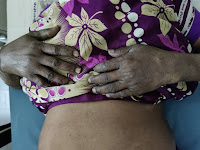a case analysis of 1818yr old male with difficulty in walking (by y.abhinav rollnrollno: 181)
I've been given this case to solve in an attempt to understand the topic of "patient clinical data analysis" to develop my competency in reading and comprehending clinical data including history, clinical findings, investigations and come up with a diagnosis and treatment plan.
You can find the entire real patient clinical problem in this link here..
https://hitesh116.blogspot.com/2020/05/elog-13th-may-2020.html?m=1
After analysing the history, clinical features, and investigations of the patient, my review about it is as follows:
The patient has
1.Difficulty in walking, in standing from sitting position,in climbing stairs,in holding chappals since 1 month, this was progressive in such a way that he could not walk without support.
2. Bilateral weakness in lower limbs since 1 month, which was first noticed by pt during getting down the tractor 1 month ago, and also h/o wasting and thinning of muscles .
3. Pain in calf muscles during walking since 1 month.
4.H/o Fever
Past history:
No h/o similar complaints in the past, no h/o any trauma, no h/o DM, HTN, CVS,EPILEPSY.
Personal history:
Pt takes mixed diet , appetite: normal, b&b movements: regular, addictions: alcoholic since 2 years , 2 times a week,
Non smoker, no significant family history.
On observing all his examination, i came to a conclusion that, he is poorly nourished, pallor is present. He was found to have Scabies on examining his hand.
On examining his motor system of lower limbs, bulk of the muscle is decreased, hypotonia in both the lower limbs, power is decreased to 3/5 which is indicative of flaccid paralysis .
Plantar reflexes absent.
Hyporeflexia is seen.
as there is hypotonia, hyporeflexia and flaccid paralysis, these are characteristic of LMN lesion.
Investigations reveal CREATININE KINASE :within normal limits .
Thyroid profile showed decreased T3 levels.
Nerve conduction study revealed bilateral common peroneal and sural axonal neuropathy.
DIFFERENTIAL DIAGNOSIS
1.Peripheral neuropathy
Which may b caused due to injury(no h/o trauma), infection (ruled out), DM( absent), hypothyroidism ( there is only mild decrease in T3 but the entire thyroid profile is not suggestive of hypothyroidism)
2.Neuromuscular conditions(like Myasthenia gravis)
Might not be a neuromuscular condition because, his CK is normal.
3.Autoimmune conditions like MS,GBS but his serology studies are normal.
4.Alcholic neuropathy(?? occurs due to longterm consumption of alcohol, this causes malabsorption of b1 b6 b9 b12, vit E and absorption of folate.
Deficiency of these b vitamins cause nerve damage.
But he is been an alcoholic since 2 years oly, and that too only twice a week, but there is no information of amount and type of alcohol consumption, due to this lack of information i could not surely diagnose it as alcoholic neuropathy. (Query)
References
1.https://hitesh116.blogspot.com/2020/05/elog-13th-may-2020.html
2.https://www.healthline.com/health/weakness-in-legs.
3.https://www.google.com/search?q=peripheral+neuropathy+due+to+hypothyroidism&oq=peripheral+neuropathy++due+to+hypothyroidism&aqs=chrome..69i57j0l3.21317j0j7&client=ms-android-samsung&sourceid=chrome-mobile&ie=UTF-8.
4.https://www.ncbi.nlm.nih.gov/books/NBK499856/
Thank you!!


